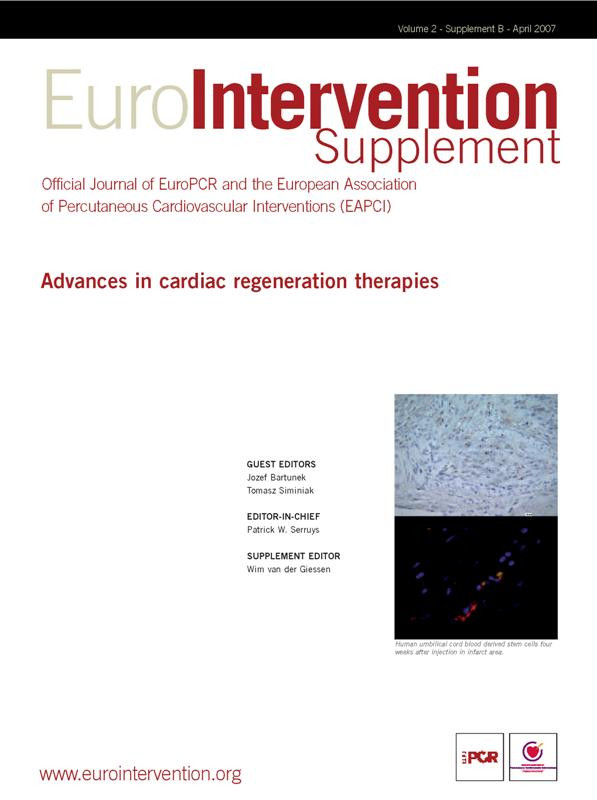“Life’s but a walking shadow; a poor player,
That struts and frets his hour upon the stage,
And then is heard no more: it is a tale
Told by an idiot, full of sound and fury,
Signifying nothing.”
—From Macbeth (V, v, 19), William Shakespeare
The iterative research process in cardiovascular stem/progenitor cell therapy is in danger of losing itself in translation. The moment at centre stage and the thrill of new discovery has now been replaced by a pessimism and scepticism that the field will never live up to the hopeful expectations of both the cardiology, and wider scientific, communities. This journal supplement exemplifies the “sound and fury” with which the interventional community in particular has embraced this new biology. However, in the minds of some sceptics, the seemingly endless permutations of cell types, delivery methods, timing of therapy, treatment targets and endpoint selection only go to reinforce the doubts raised that the hope will never live up to the hype.
Nonetheless, aside from the mechanistic doubts and incremental clinical benefits seen in the early phase studies, the stem cell and regenerative medicine field has already produced many valuable bystander benefits for the interventional community. The emergence of endothelial progenitor cell biology and its role in atherogenesis have added greatly to our understanding of vessel healing following angioplasty. Indeed the EPC capture stent could well emerge as a very successful example of rapid clinical translation and therapies which modify EPC numbers and function are an intense area of interventional research. Additionally the search for the perfect surrogate endpoint in stem cell trials continues to drive the development of cross sectional and 3D imaging technologies such as MRI and CT. Moreover, for guidance of stem cell therapy the 3D electromagnetic guidance systems such as NOGA-XP and Stereotaxis may well have found their true niche application in stem cell delivery, although these technologies could well have many wider applications.
Going back to Orlic’s initial landmark studies which ignited the field of cardiac regeneration1,2 there has been a precipitous rush to clinic with several hundred patients having been treated with various forms of stem cell therapy given by various routes for a number of different indications3-7. However in parallel with these clinical endeavours there has been a proliferation of further preclinical studies which have tended to refute the original postulated mechanisms of regeneration8,9. Indeed it is now accepted the potential mechanism of any therapeutic effect is probably unknown but may well be a paracrine process rather than any direct cellular effect10.
Amidst all this confusion over targets, mechanisms, imaging endpoints and trial design with autologous cell therapy a new landmark study has fortuitously appeared, this time in the clinical arena. The unexpected positive findings from the Osiris Therapeutics trial reported at the American College of Cardiology in 2007 will undoubtedly ignite another rush as the stem cell and interventional community embrace the “new new paradigm” of allogeneic cell therapy. Initially designed and conceived at the National Institutes of Health and approved by the FDA, this randomised, double blind, placebo controlled, dose escalation study could be conceived as a model example of how to design and conduct an early phase clinical trial. However, the true significance of this approach lies in the use of intravenously delivered allogeneic mesenchymal stem cells in an adult non-immunocompromised population without the need for any immunosuppression. The implications of this fact alone will be far reaching, and could well signal the end of many forms of autologous adult stem cell therapy as well as embryonic stem cell therapy. Additionally, using the intravenous delivery route without any definitive preclinical evidence in a large animal models that the MSCs actually traffic and home to injured myocardium could be regarded as a strength rather than a weakness of this study. What this may well have established is that rather than the direct cellular regenerative effect, this now firmly established the concept of the mesenchymal stem cell as a “cytokine factory” positively modulating a wound healing response in a paracrine fashion as more likely explanation for the unexpected clinical benefits that have been reported.
So cardiovascular stem and progenitor cell biology and therapeutics may not be such a “poor player” destined to “tell a tale... signifying nothing”. As the scientific and interventional community embarked on this original high speed journey it has not come to an abrupt halt or been thrown into reverse, but has merely changed direction, enriched and emboldened by the knowledge gleaned thus far. Cardiovascular stem and progenitor cell biology will remain one of the most promising areas of scientific and interventional research and may yet realise that promise sooner than we expect.

